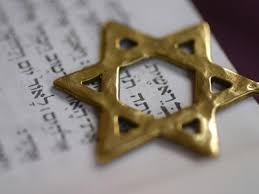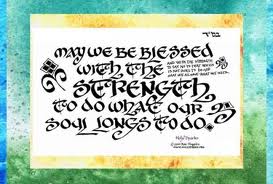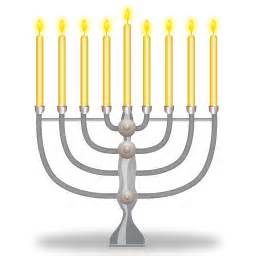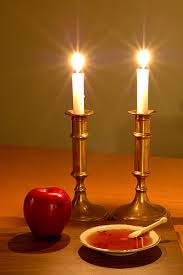| he Jewish Spiritual Tradition | |
| October 2015 Focus: Jewish Spiritual Tradition |  |
| Greetings and Expressions (in Hebrew) Shalom (shah-LOHM) Literally, means “Peace.” It is a way of saying “hello” or “goodbye” to friends, family, etc. Mazel Tov (MAH-zl TAWV) literally means, “Good luck!” This is the traditional way of expressing congratulations. It can be used to congratulate someone for getting a new job, graduating from college, or any other happy event. It should not be used to wish someone luck in the future. Rather, it is an expression of pleasure at the good luck someone has already had. Yasher koach (YAH-shehyr KOH-ahkh) Literally, means “Straight strength.” Figuratively, “May you have strength, or may your strength be increased.” It is a way of congratulating someone for performing a good deed. In essence, you are wishing this person the strength to continue doing this good thing. It is most commonly used in synagogue, to congratulate someone after he or she has participated in some aspect of the service. Shabbat Shalom (shah-BAHT shah-LOHM) means, “Sabbath Peace or peaceful Sabbath.” This is an appropriate greeting at any time on Shabbat, although it is most commonly used at the end of a shabbat service. L’Shanah Tovah (li-SHAH-nuh TOH-vuh) meaning – “A good year.” It is a common greeting during Rosh Hashanah, the Jewish New Year.info from last year | |
| September 2014 Focus: Jewish – Judaic Spiritual Tradition |  |
Jewish Beliefs (for Sept 5)One God – Unlike many religions, Judaism has no dogma, or formal set of beliefs which one must hold in order to be a Jew. Central to Judaism is the belief that there is only one God, who created the world and is all-knowing and all-powerful. Judaism is the oldest surviving monotheistic religion.The Ten Commandments – were given by God to Moses at Mount Sinai and must be observed by all Jews. Five Commandments deal with the individual’s relationship with God and five deal with the individual’s relationships with other people.The 613 Commandments – or mitzvoth – are found in the Torah and include the Ten Commandments. Because Judaism focuses more on actions than beliefs, religious Jews are expected to follow all 613 commandments. In actuality, many pertain to rituals carried out in the First and Second Temples by the priests and are not relevant today. Some commandments have been adapted to modern times, such as the prohibition against lighting a fire on the Sabbath. This has been interpreted to include turning on electricity, which is forbidden on the Sabbath even though it was unknown in Biblical times. Maimonides Principles of Faith – Moses Maimonides lived from 1135 – 1204. He was a rabbi, physician and philosopher who was born in Spain, lived in North Africa and Palestine, and died in Egypt. He wrote many theological works which remain important today. He composed 13 principles of faith that are widely accepted. These include the uniqueness of God, the importance of the Torah as God’s law, the coming of the messiah (redeemer), and the resurrection of the dead.Jewish Proverbs Maimonides Principles of Faith – Moses Maimonides lived from 1135 – 1204. He was a rabbi, physician and philosopher who was born in Spain, lived in North Africa and Palestine, and died in Egypt. He wrote many theological works which remain important today. He composed 13 principles of faith that are widely accepted. These include the uniqueness of God, the importance of the Torah as God’s law, the coming of the messiah (redeemer), and the resurrection of the dead.Jewish ProverbsIf you wait to find the meaning of life, will there be enough life left to live meaningfully? As he thinks in his heart, so he is. As you teach, you learn. Do not be wise in words, be wise in deeds. First mend yourself, and then mend others. A bird that you set free may be caught again, but a word that escapes your lips will not return(earlier) Jewish Denominations and Worship (for Sept 12)Judaism is divided into three major movements in the United States: Orthodox Judaism (the only movement of Judaism recognized in Israel today; Reform Judaism, which believes that the individual has the right to adapt religious beliefs and traditions to suit contemporary society, and emphasizes the ethics of Judaism; and Conservative Judaism – which attempts to conserve Jewish law and tradition, while adapting it to contemporary needs.Worship Religious Jews are required to say their prayers three times a day. Most of the prayers can be said alone, but certain prayers require the presence of a minyan, consisting of ten adult male Jews. In addition, prayers and blessings are recited throughout the day before eating and drinking and on other occasions.While praying, Jewish males wrap themselves in a white prayer shawl. A skull cap, called a kippah or yarmulke, is always worn during prayers and religious Jews wear one at all times. Phylacteries or tefillin, two small leather boxes containing portions of the Torah, are wrapped around the arms and head by black leather straps during the morning prayers.Besides the Torah, which is the Hebrew Bible, two other important Jewish Religious books are The Talmud (a compilation of discussions by rabbis over several hundred years), and The Kabbalah (a series of writings growing out of the tradition of Jewish Mysticism.Jews go to synagogue to pray together. The synagogue acts as a house of study, for traditional Jewish males continue to study throughout their lives. In Orthodox synagogues, the men and women are separated from each other with a partition. Services are usually conducted by the rabbi, but members of the congregation can also lead the service, and a rabbi is not required. The heart of the service is the reading of a portion of the Torah.All Reform, and most Conservative synagogues have egalitarian participation, in which women read from the Torah and lead services.Jewish Proverb Do not be wise in words, be wise in deeds. —  Inspirational messageBar Mitzvah and Bat Mitzvah (for Sept 19) Bar Mitzvah and Bat Mitzvah are Jewish coming of age rituals. Bar is a Jewish Babylonian Aramaic word literally meaning ‘son’, while bat means ‘daughter’ in Hebrew, and mitzvah means ‘commandment’ or ‘law’. Thus bar mitzvah and bat mitzvah literally translate to “son of commandment” and “daughter of commandment”.Today many non-Orthodox Jews celebrate a girl’s bat mitzvah in the same way as a boy’s bar mitzvah. The age of b’nai mitzvah roughly coincides with physical puberty.[1] The bar or bat mitzvah ceremony is usually held on the first Shabbat after a boy’s thirteenth and a girl’s twelfth birthday, following an intensive period of study.According to Jewish law, when Jewish boys become 13 years old, they become accountable for their actions and become a bar mitzvah, and are called to read the Torah in the synagogue. The boy is now considered a man in the eyes of the Jewish religion and obligated to fulfill the commandments of the Torah. A girl becomes a bat mitzvah at the age of 12 according to Orthodox and Conservative Jews, and at the age of 13 according to Reform Jews.Prior to reaching bar mitzvah, the child’s parents hold the responsibility for the child’s actions. After this age, the boys and girls bear their own responsibility for Jewish ritual law, tradition, and ethics, and are able to participate in all areas of Jewish community life. In addition to being considered accountable for their actions from a religious perspective, b’nai mitzvah may be counted towards a minyan (prayer quorum) and may lead prayer and other religious services in the family and the community.Jewish Inspiration “How wonderful it is that nobody need wait a single moment before starting to improve the world.” Anne Frank  Jewish Holy TabletsShabbat, The Jewish Sabbath and Yom Kippur, the Day of Atonement (for Sept 26) Holy days are celebrated in prayer and family time. The weekly holy day is Shabbat, the Jewish Sabbath, celebrated every week from sundown on Friday to nightfall of Saturday. It is a time to regroup and pray, to eat and rejoice, to spend time with family and friends, to study and share—to focus on a person’s spiritual side. Yom Kippur, known as Day of Atonement, is the holiest day of the year for the Jewish people. This year it is celebrated on October 3-4. Jewish people traditionally observe this holy day with an approximate 25-hour period of fasting and prayer, spending most of the day in synagogue services. Its central themes are atonement and repentance, to release the “sins or transgressions” of the past. The message of Yom Kippur from the Torah is about discernment:“Just as God separated the light from the darkness (Gen 1:4) so we are called to discern between the realms of the holy and the profane, the sacred and the common, and the clean and the unclean.” Shabbat, The Jewish Sabbath (for Sept 26) -additional infoIn Hebrew, Shabbat means “resting.” As is recounted in the beginning of the Book of Genesis, when God created the world in six days and refrained from creating on the seventh. The observance of Shabbat by the Jewish nation is mandated in the fourth of the Ten Commandments.Shabbat is ushered in on Friday afternoon with the lighting of candles by women and girls. Following the special Friday night Shabbat evening prayers (preferably in the synagogue) the family partakes of a festive meal which is an integral part of oneg Shabbat, “delighting in the Shabbat.” It is opened by the Kiddush blessing over a cup of wine or grape juice, and the Hamotzie blessing over two whole loaves of bread called Challah. As cooking and baking is not allowed on Shabbat, much of the food preparation is done in advance.On Shabbat morning, the family holds a prayer service which features the weekly public reading of the Torah. After the prayers is another festive meal, complete with Kiddush and Hamotzie. In the afternoon, the family enjoys a smaller meal, called Seudah Shlishit.Shabbat ends after nightfall on Saturday. It is marked with the brief Havdalah, (separation) service which marks the departure of the holy day of rest.Jewish Proverb “I ask not for a lighter burden, but for broader shoulders.”info from 2013 | |
| September 2013 Focus: Jewish Spiritual Tradition |  Be “a light unto the nations” Be “a light unto the nations” Isaiah 42:6 |
Hanukkah – Festival of the LightsHanukkah (also known as Chanukah or Chanukkah), or the Festival of Lights, is an eight-day Jewish holiday commemorating the rededication of the Holy Temple in Jerusalem at the time of the Maccabean Revolt against the Greeks in 2nd century BCE. When the Maccabees entered the temple to purify and rededicate it, they discovered that there was only enough oil to light the temple menorah for one day. They lit it anyway and a miracle happened. The lamps burned continuously for eight days until more oil could be brought to the temple. That is why Hanukkah is celebrated for eight days, starting on the 25th day of Kislev according to the Hebrew calendar. This year, Hanukkah will occur between November 27-December 5, 2013. The spiritual meaning of Hanukkah is one of faith in God; in remaining true to one’s traditional beliefs even when forbidden to do so by the authorities and is a story about the courage of the Maccabees. They risked their lives and won against all odds because they believed in the courage of their convictions. Candle Lighting Ceremony Candle Lighting CeremonyThe festival is observed by the kindling of the lights of a unique candelabrum, the nine-branched Menorah, one additional light on each night of the holiday, progressing to eight on the final night. The typical Menorah consists of eight branches with an additional raised branch. The extra light is called a shamash (or shamus) and is given a distinct location, usually above or below the rest. The purpose of the shamash is to have a light available for practical use. Using the Hanukkah lights themselves for purposes other than celebrating and meditating on the Hanukkah is forbidden. Candles are added to the menorah from right to left (like Hebrew writing). The shamus candle is lit first, then the blessings are recited while holding the candle. Using the shamus to light the Hanukkah candles, they are lit from left to right (newest to oldest). Candles must burn for more than half an hour and are left burning until they go out on their own ( normally one hour).Blessing over Candles Blessed are you, Lord, our God, sovereign of the universe Who has sanctified us with His commandments and commanded us to light the lights of Chanukkah. (Amen) Blessing for the Chanukkah Miracle Blessed are you, Lord, our God, sovereign of the universe Who performed miracles for our ancestors in those days at this time Shehecheyanu (Who Has Kept Us Alive) This blessing is recited only on the first night of Chanukkah. Blessed are you, Lord, our God, sovereign of the universe who has kept us alive, sustained us, and enabled us to reach this season (Amen) Ref: jewfaq – chanukah Ref: ehow.com – meaning-chanukah | |
| ROSH HASHANAHRosh Hashanah is the Jewish New Year and like most Jewish holidays there are food customs associated with it. One of the most popular and well-known food customs on Rosh Hashanah has to do with dipping apple slices into honey. This sweet combination stems from an age-old Jewish tradition of eating sweet foods to express our hope for a sweet new year. In addition to symbolizing our hopes for a sweet new year, according to Jewish mysticism the apple represents the Shekhinah (the feminine aspect of God). During Rosh Hashanah some Jews believe the Shekhinah is watching us and evaluating our behavior during the past year. Eating honey with apples represents our hope that the Shekhinah will judge us kindly and look down on us with sweetness. Beyond its association with the Shekhinah, ancient Jews thought apples had healing properties. Rabbi Alfred Koltach writes in The Second Jewish Book of Why that whenever King Herod (73-4 B.C.E.) felt faint he would eat an apple, and that during Talmudic times apples were frequently sent as gifts to people in ill health (pg 328).  The Blessing For Apple and Honey Though apple and honey can be eaten throughout the holidays, they are almost always eaten together on the first night of Rosh Hashanah. Jews dip apple slices into honey and say a prayer asking God for a sweet New Year. There are three steps to this ritual:1. Say the first part of the prayer, which is a blessing thanking God for the apples: Blessed are you Lord, our God, Ruler of the world, Creator of the fruit of the tree. (Baruch atah Ado-nai, Ehlo-haynu melech Ha-olam, Borai p’ree ha’aitz.) 2. Take a bite of the apple slices dipped in honey. 3. Now say the second part of the prayer, which asks God to renew us during the New Year: May it be Your will, Adonai, our God and the God of our forefathers, that You renew for us a good and sweet year. (Y’hee ratzon mee-l’fanekha, Adonai Elohaynu v’elohey avoteynu sh’tichadeish aleinu shanah tovah um’tuqah )The ShofarThe shofar is a Jewish instrument most often made from a ram’s horn, though it can also be made from the horn of a sheep or goat. It makes a trumpet-like sound and is traditionally blown on Rosh HaShanah, the Jewish New Year. According to some scholars, the shofar dates back to ancient times when making loud noises on the New Year was thought to scare off demons and ensure a happy start to the coming year. The shofar is such an important part of this holiday that another name for Rosh HaShanah is Yom Teruah, which means “day of the shofar blast” in Hebrew.  The shofar is blown one hundred times on each of the two days of Rosh HaShanah. If one of the days of Rosh HaShanah falls on Shabbat, however, the shofar is not blown. The person who blows the shofar is called a Tokea (which literally means “blaster”) and it is no easy task to perform each of these sounds. The shofar is blown one hundred times on each of the two days of Rosh HaShanah. If one of the days of Rosh HaShanah falls on Shabbat, however, the shofar is not blown. The person who blows the shofar is called a Tokea (which literally means “blaster”) and it is no easy task to perform each of these sounds. According to the famous Jewish philosopher Maimonides, the sound of the shofar on Rosh HaShanah is meant to wake up soul and turn its attention to the important task of repentance (teshuvah). | |
| The Psalms For time immemorial, whenever Jews found themselves in difficult situations, whether individually or communally, they would open up the Book of Psalms and use King David’s ageless poetic praises and supplications to beseech God for mercy. The Midrash tells us that when King David compiled the Psalms, he had in mind himself, as well as every Jew of every generation and every circumstance. No matter who you are and what the situation, the words of the Psalms speak the words of your heart and are heard On High.A Psalm by David The Lord is my shepherd, I shall lack nothing. He lays me down in green pastures; He leads me beside still waters. He revives my soul; He directs me in paths of righteousness for the sake of His Name. Though I walk in the valley of the shadow of death, I will fear no evil, for You are with me; Your rod and Your staff-they will comfort me. You will prepare a table for me before my enemies; You have anointed my head with oil; my cup is full. Only goodness and kindness shall follow me all the days of my life, and I shall dwell in the House of the Lord for many long years. ref. www.chabad.org Ref: Wikipedia | |
| SPIRIT CALL Sept 13 – President’s Message on the Jewish TraditionYOM KIPPURConsidered the holiest day of the Jewish year, Yom Kippur is the day when Jews reflect on the past year as they atone for their sins. Known as the Day of Atonement, Yom Kippur begins at sundown on Sept. 13 and continues until nightfall on Sept. 14, At this time, Jews use the time as a time of cleansing to seek forgiveness for sins committed between man and God. They make a pledge to avoid repeating the same mistakes in the new year. The holiday includes a 25-hour period of fasting and intensive prayer. There are five prayer services over the course of the day. The singular prayer of Yom Kippur is the “Al Chet”, a recitation, said aloud and in unison, of a formal list of 44 sins and omissions expressed throughout the Day of Atonement. The goal of the “Al Chet” prayer that is said many times during Yom Kippur services is to get to the root of the problem, so you can eliminate it entirely. These 44 statements are not a list of mistakes, but rather identify the roots of mistakes. Some examples of the 44 “sins and omissions” include: We atone For the mistakes we committed before You under duress and willingly. For the mistakes we committed before You through having a hard heart. For the mistakes we committed before You without thinking (or without knowledge). For the mistakes we committed before You through harsh speech.The prayer is also as an expression of *group* responsibility for the sins of the individuals. Traditional Jews thump their chest with their fist at every sentence. Usually this is done gently, symbolically, but traditional men may vigorously “beat their chests” in expressing their repentance.  The blast of the shofar (or ram’s horn) signals the end of the Day of Atonement and marks the time when congregants head home for the highly anticipated “breaking of the fast” meal and family celebration. The blast of the shofar (or ram’s horn) signals the end of the Day of Atonement and marks the time when congregants head home for the highly anticipated “breaking of the fast” meal and family celebration.We acknowledge the spirit of this sacred holiday and wish our Jewish brothers and sisters a peaceful celebration. | |
SPIRIT CALL Sept 6- Message from the President The holy celebration of Rosh Hashanah begins this weekend, signaling the beginning of the Jewish New Year. This inspiration is called “Meaning In Time,” shared during the Morning Service of Rosh Hashanah: “God of all lands and ages, the ground under our feet is holy; the light that shines for us is Yours; the world glows with your presence. You are just beyond the horizon of the mind, a vision new to us yet seen before, like a memory of the future, a promise already kept.We remember Abraham and Isaac walking together toward their mountain; Jacob dreaming of a ladder to link heaven and earth; Moses turning aside to look at the common bush burning with a divine flame; David dancing before the Arc of Your Covenant; a shepherd prophet roaring Your word like a lion; the days and years of our own lives – a search for light in a dark and dusty time. And we remember a rainbow.” The holy celebration of Rosh Hashanah begins this weekend, signaling the beginning of the Jewish New Year. This inspiration is called “Meaning In Time,” shared during the Morning Service of Rosh Hashanah: “God of all lands and ages, the ground under our feet is holy; the light that shines for us is Yours; the world glows with your presence. You are just beyond the horizon of the mind, a vision new to us yet seen before, like a memory of the future, a promise already kept.We remember Abraham and Isaac walking together toward their mountain; Jacob dreaming of a ladder to link heaven and earth; Moses turning aside to look at the common bush burning with a divine flame; David dancing before the Arc of Your Covenant; a shepherd prophet roaring Your word like a lion; the days and years of our own lives – a search for light in a dark and dusty time. And we remember a rainbow.” –from Gates of Repentance | |
Wayshowers Community Fellowship
Creating Spiritual Community
